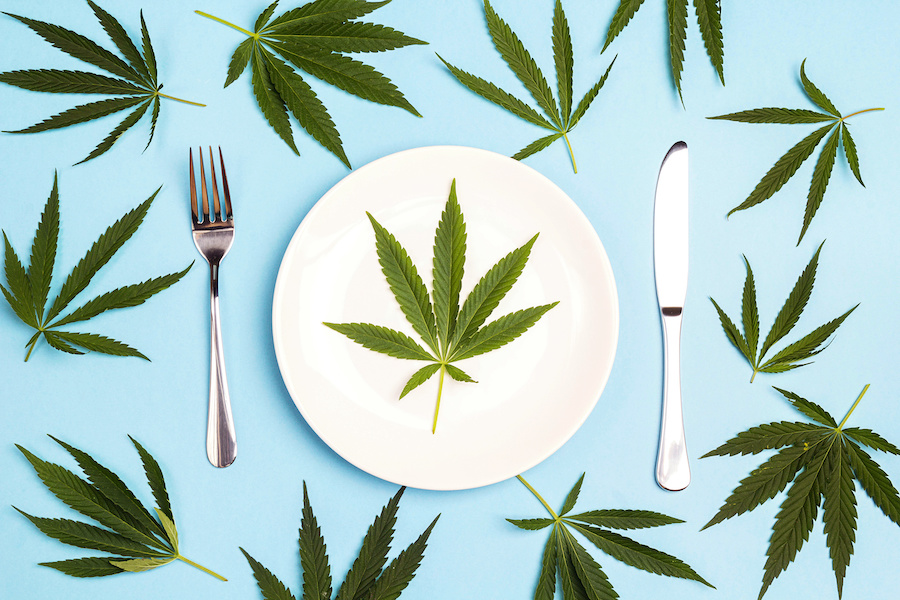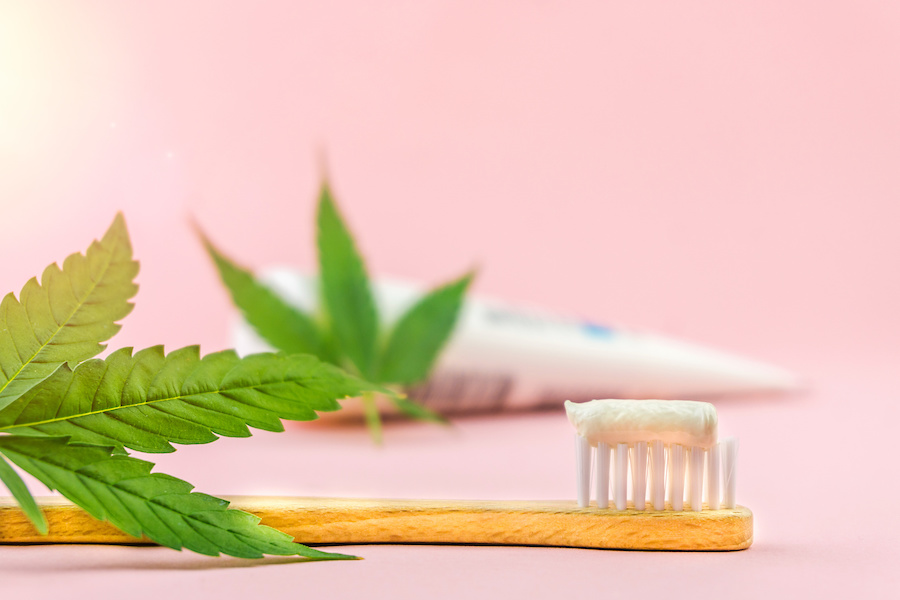Can Medical Marijuana Help Skin Ulcers, Stomach Ulcers, & Oral Ulcers?
When it comes to ulcers, they can be awful and painful. Regardless of whether you think of oozy and infected wounds or your gut cringes from stomach pain, these persistent and open wounds found in a few places around your body are no joke. Some ulcers simply go away in a few days to a few weeks such is the case with some ulcers found in the mouth. While stomach ulcers may make it difficult to eat, ulcers or open wounds on the skin can lead to infections, gangrene, cancers, and amputations. Thankfully there has been a lot of research into various types of ulcers and how medical cannabis may be able to help in your recovery process.
Cannabis contains over 100 cannabinoids, terpenes, and other natural compounds that have a variety of healing effects in our bodies. The most common cannabinoids are Δ9-tetrahydrocannabinol (THC) and cannabidiol (CBD) and are highly sought after for their potential effects. Cannabinoids interact with our body through the endocannabinoid system (ECS). The ECS is a complex system of cannabinoid receptors CB1 and CB2 that interact with fat-based neurotransmitters that our body naturally produces. CB1 receptors are thought to generally affect the central nervous system while CB2 receptors can be found in a variety of tissues and organs. By ingesting cannabis, the cannabinoid receptors are activated and can raise and lower endocannabinoids such as anandamide (AEA) and 2-arachidonoylglycerol (2-AG).
The endocannabinoids in our body are responsible for a variety of essential functions including how we perceive pain, calming inflammation, slowing digestion, and allowing our body to maintain homeostasis. Through medical cannabis, researchers have found that these bodily functions can be improved or changed to help us relieve symptoms of many chronic conditions.
Skin Ulcers and Medical Cannabis
Skin ulcers are no laughing matter and can be much more than long-lasting wounds. They can often be caused by circulation issues where blood flow is reduced or cut-off, mostly in the legs, and sores form. Ulcers on the skin can also be caused by injuries that have not healed properly. Another type of ulcer called decubitus ulcers is caused when people who are ill and have reduced mobility sit on pressure points on their skin too long and sores form. These are also known as bedsores. Fortunately, there is a lot of research that supports the use of medical cannabis for chronic pain, skin wounds, and healing skin inflammation in conditions such as eczema, psoriasis, and acne (23).
Please check out our page on skin ulcers for more details.
Medical Marijuana and Peptic Ulcers
Peptic ulcers, also known as gastric ulcers, duodenal ulcers, or stomach ulcers are open sores that are found in our stomach or the first part of the small intestine called the duodenum. They are extremely painful and can cause other digestive issues including acid reflux, loss of appetite, possibly gastric cancer, abdominal pain, and nausea. Though doctors used to think the primary cause of peptic ulcers was stress, now they know they are often caused by a type of bacteria called H. Pylori or by overuse of non-steroidal anti-inflammatory drugs (NSAIDs).
Research regarding medical cannabis shows that when THC is used in high concentrations it can slow stomach acid secretions and the digestive tract, which slows gastric emptying (15). They also believe that it can reduce pain and inflammation in the stomach lining as well as damage to this mucosal layer (9). Typically gastric ulcers can be treated with antacids, proton pump inhibitors to control acid production, and antibiotics.
Please check out our page on stomach ulcers for more information.
Oral Ulcers and Cannabis Use
Ulcers in the mouth can be bothersome, but they usually go away quickly. They can be caused by a variety of factors including oral herpes (cold sores), canker sores, head and neck cancers, or irritations in the mouth. Research published in the Journal of Dental Research supports the use of CBD for healing stomach ulcers that are caused by acidic foods or trauma (16). This research also shows that oral spray application of CBD reduces the number of cells that die from inflammatory cascades and accelerates oral ulcer healing.
Please check out our page on oral ulcers for more information.
Note: Veriheal does not intend to give this as professional medical advice. Do not attempt to self-diagnose, or prescribe treatment based on the information provided on this page. Always consult a physician before making any decision on the treatment of a medical condition.
1. Armstrong, D. G., Orgill, D. P., Galiano, R., Glat, P. M., Carter, M., Zelen, C. M., & Li, W. W. (2020). Complete wound closure following a single topical application of a novel autologous homologous skin construct: First evaluation in an open‐label , single‐arm feasibility study in diabetic foot ulcers. International Wound Journal, 17(5), 1366–1375. https://onlinelibrary.wiley.com/doi/full/10.1111/iwj.13404
2. Ayelo, G. A., Sopoh, G. E., Houezo, J.-G., Fiodessihoue, R., Affolabi, D., Dossou, A. D., Barogui, Y. T., Wadagni, A. A., Agossadou, D. C., Hasker, E., Portaels, F., de Jong, B. C., & Eddyani, M. (2018). Improving clinical and epidemiological predictors of Buruli ulcer. PLOS Neglected Tropical Diseases, 12(8). https://journals.plos.org/plosntds/article?id=10.1371/journal.pntd.0006713
3. Baswan, S. M., Klosner, A. E., Glynn, K., Rajgopal, A., Malik, K., Yim, S., & Stern, N. (2020). Therapeutic Potential of Cannabidiol (CBD) for Skin Health and Disorders. Clinical, cosmetic and investigational dermatology, 13, 927–942. https://www.ncbi.nlm.nih.gov/pmc/articles/PMC7736837/
4. Cocchiara E, Spinella A, Magnani L, et alAB0645 CANNABINOIDS IN THE TREATMENT OF PAIN RELATED TO SYSTEMIC SCLEROSIS SKIN ULCERS: OUR EXPERIENCE Annals of the Rheumatic Diseases 2019;78:1784. https://ard.bmj.com/content/annrheumdis/78/Suppl_2/1784.1.full.pdf
5. Correia-Sá, I.B., Carvalho, C.M., Serrão, P.V. et al. A new role for anandamide: defective link between the systemic and skin endocannabinoid systems in hypertrophic human wound healing. Sci Rep 10, 11134 (2020). https://www.nature.com/articles/s41598-020-68058-3
6. Du, Y., Ren, P., Wang, Q. et al. Cannabinoid 2 receptor attenuates inflammation during skin wound healing by inhibiting M1 macrophages rather than activating M2 macrophages. J Inflamm 15, 25 (2018). https://journal-inflammation.biomedcentral.com/articles/10.1186/s12950-018-0201-z
7. Dudding, T., Haworth, S., Lind, P.A. et al. Genome wide analysis for mouth ulcers identifies associations at immune regulatory loci. Nat Commun 10, 1052 (2019). https://www.nature.com/articles/s41467-019-08923-6
8. Eagleston, L. R., Kalani, N. K., Patel, R. R., Flaten, H. K., Dunnick, C. A., & Dellavalle, R. P. (2018). Cannabinoids in dermatology: A scoping review. Dermatology Online Journal, 24(6). https://escholarship.org/uc/item/7pn8c0sb
9. Gotfried, J., Kataria, R., & Schey, R. (2017). Review: The role of cannabinoids on esophageal function—what we know thus far. Cannabis and Cannabinoid Research, 2(1), 252–258. https://www.liebertpub.com/doi/10.1089/can.2017.0031
10. Koyama, S., Purk, A., Kaur, M., Soini, H. A., Novotny, M. V., Davis, K., Kao, C. C., Matsunami, H., & Mescher, A. (2019). Beta-caryophyllene enhances wound healing through multiple routes. PLOS ONE, 14(12). https://journals.plos.org/plosone/article?id=10.1371/journal.pone.0216104&fbclid=IwAR23DdST1mIa_xaEqbVf7q4WRSLPKhCrDUnYbIDBQ4hKJlLFKDkO_J84VOQ
11. LI, S. H. A. N.-S. H. A. N., WANG, L. I. N.-L. I. N., LIU, M. I. N., JIANG, S. H. U.-K. U. N., ZHANG, M. I. A. O., TIAN, Z. H. I.-L. I. N. G., WANG, M. E. N. G., LI, J. I. A. O.-Y. O. N. G., ZHAO, R. U. I., & GUAN, D. A.-W. E. I. (2016). Cannabinoid CB2 receptors are involved in the regulation of fibrogenesis during skin wound repair in mice. Molecular Medicine Reports, 13(4), 3441–3450. https://www.spandidos-publications.com/10.3892/mmr.2016.4961
12. Maida, V., Shi, R. B., Fazzari, F. G., & Zomparelli, L. (2021). Topical cannabis‐based medicines – a novel adjuvant treatment for venous leg ulcers: An open‐label trial. Experimental Dermatology, 30(9), 1258–1267. https://onlinelibrary.wiley.com/doi/abs/10.1111/exd.14395
13. Maida, V., & Corban, J. (2017). Topical medical cannabis: A new treatment for wound pain—three cases of pyoderma gangrenosum. Journal of Pain and Symptom Management, 54(5), 732–736. https://www.sciencedirect.com/science/article/pii/S0885392417303512
14. NHS. (2018, September 17). Stomach Ulcer Causes. Nhs choices. https://www.nhs.uk/conditions/stomach-ulcer/causes/
15. PERTWEE, R. G. (2001). Cannabinoids and the gastrointestinal tract. Gut, 48(6), 859–867. https://www.ncbi.nlm.nih.gov/pmc/articles/PMC1728337/
16. Qi, X., Lin, W., Wu, Y., Li, Q., Zhou, X., Li, H., Xiao, Q., Wang, Y., Shao, B., & Yuan, Q. (2021). CBD promotes oral ulcer healing via inhibiting CMPK2-mediated inflammasome. Journal of Dental Research, 002203452110245. https://journals.sagepub.com/doi/abs/10.1177/00220345211024528
17. Reiss C. S. (2010). Cannabinoids and Viral Infections. Pharmaceuticals (Basel, Switzerland), 3(6), 1873–1886. https://www.ncbi.nlm.nih.gov/pmc/articles/PMC2903762/
18. Schräder, N. H. B., Duipmans, J. C., Molenbuur, B., Wolff, A., & Jonkman, M. F. (2019). Combined THC and CBD to treat pain in eb. British Journal of Dermatology, 180(4). https://onlinelibrary.wiley.com/doi/abs/10.1111/bjd.17662
19. Wang, L.-L., Zhao, R., Li, J.-Y., Li, S.-S., Liu, M., Wang, M., Zhang, M.-Z., Dong, W.-W., Jiang, S.-K., Zhang, M., Tian, Z.-L., Liu, C.-S., & Guan, D.-W. (2016). Pharmacological activation of cannabinoid 2 receptor attenuates inflammation, fibrogenesis, and promotes re-epithelialization during skin wound healing. European Journal of Pharmacology, 786, 128–136. https://www.sciencedirect.com/science/article/abs/pii/S0014299916303661
20. Weigelt, M. A., Sivamani, R., & Lev‐Tov, H. (2020). The therapeutic potential of cannabinoids for Integumentary Wound Management. Experimental Dermatology, 30(2), 201–211. https://onlinelibrary.wiley.com/doi/full/10.1111/exd.14241
21. Yeisley, D. J., Arabiyat, A. S., & Hahn, M. S. (2021). Cannabidiol-driven alterations to inflammatory protein landscape of lipopolysaccharide-activated macrophages in vitro may be mediated by autophagy and oxidative stress. Cannabis and Cannabinoid Research, 6(3), 253–263. https://www.liebertpub.com/doi/10.1089/can.2020.0109
22. Zheng, JL., Yu, TS., Li, XN. et al. Cannabinoid receptor type 2 is time-dependently expressed during skin wound healing in mice. Int J Legal Med 126, 807–814 (2012). https://link.springer.com/article/10.1007/s00414-012-0741-3
23. Milando, R., & Friedman, A. (2018). Cannabinoids: Potential role in inflammatory and neoplastic skin diseases. American Journal of Clinical Dermatology, 20(2), 167–180. https://link.springer.com/article/10.1007%2Fs40257-018-0410-5








